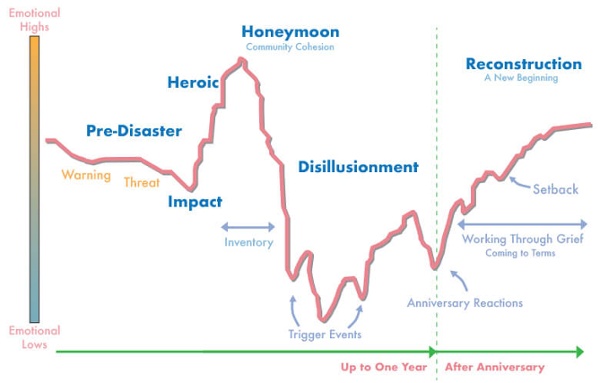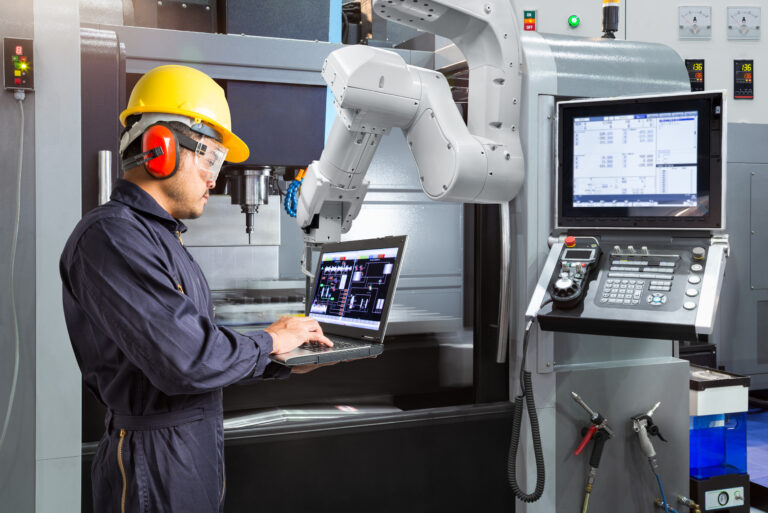We can all agree the current COVID-19 global pandemic and the economic, employment, and social upheaval it’s causing is disastrous. So much is uncertain from day to day and it seems the outlook for health and business changes with each new news story. Business leaders might instinctively decide to table many of their plans and focus on maintaining the status quo for the foreseeable future.
At a time like the present, it can certainly feel like the current situation will last forever and that things will never return to how they were. But as with all disaster situations, time goes on, and with it, business. We still have to prepare for the future, even if it seems distant and out of focus while we deal with the crisis each day.
Recently, we’ve been studying a graph produced by the US Department of Health and Human Services and wanted to share it with you. We think it might be helpful as you plan for the future of your manufacturing business. It maps the emotional phases of a disaster over time, as shown below:

You might wonder how a graph of emotional responses is helpful in the business world. In our view, companies are made of individuals, each of whom have emotional responses that contribute to the collective company response to the situation.
Six phases in a disaster situation
- Pre-disaster. The time before disaster strikes, though there may or may not be a warning or threat. The time when companies proceed with “business as usual,” planning for future quarters, growth, changes, etc.
- Impact. The event hits, as in the case of a physical disaster, or starts to have significant impact on daily life. This is when most companies experience a drop in orders and income, supply chain disruptions, layoffs, effects of illness on workers, etc.
- Heroic phase. A time of pulling together in the immediate aftermath of a crisis point. Companies may make attempts to change their business model or production, institute stopgap solutions for remote work, reduce production or hours of operation. Many will make incredible efforts to maintain operations, stay in business, or pay employees.
- Honeymoon. The feelings of positivity about the changes in place, and the sense that things will be OK because everyone is pitching in and working toward a common goal.
- Disillusionment. The harsh realization that it will be difficult to maintain the current situation for the long term. Companies start to find it hard to keep employees on their payroll if orders are still not coming in, or if they can’t adapt their production capabilities to new products or opportunities.
- Reconstruction. A period of reflection on achieving a “new normal” and grief over what was lost. Businesses will be re-examining priorities and letting go of some plans. But it can also be a time of realizing areas of resilience and available resources.
It’s important to remember none of these stages lasts forever, and they aren’t sustainable long term no matter how much we may want them to last (in particular, the heroic and honeymoon phases). Things are in flux and will continue to be so for a while. The very real economic changes manufacturers are experiencing may point to fluctuation in production needs and a higher mix of products to manufacture. Your options could boil down to trying to maintain they way you used to do things or finding a way to stay forward thinking, poised for growth, and agile.
Key lessons for manufacturers
These are our major takeaways from applying the graph to manufacturing companies:
Don’t underestimate how long the transition to post-disaster takes. During the honeymoon phase it may feel like the worst is over and business will start to pick up. But in the graph, the disillusionment and reconstruction phases are happening during and well after the one-year anniversary mark of the initial impact. Prepare yourself for a long haul, including ways to keep your business going in changing times.
Progress rarely follows a straight line. Anticipate some setbacks of this economic and public health crisis. Perhaps the laid off employees you want to rehire found new jobs, or you lose a major customer. The best way to smooth out what may feel like a roller coaster is to set yourself up for flexible manufacturing and the ability to pivot to alternative products quickly. This way you can be in a stronger position to deal with new products and opportunities and fluctuations in staff.
The very end of the graph is actually higher than the start. The point of resolution is far out from where we are now, but if you approach your business with the mindset that the present situation won’t last forever, your business could come out in a better position in the end. Now is the time to be planning and investing in your capabilities and ability to jump on opportunities that present themselves in the next several months. You’ll increase the odds of boosting production, diversifying your customer base, making work more enjoyable for employees, and meeting changing staffing and skill needs.
Manufacturing automation opens new opportunities and smooths the transition. As we’ve noted before, investing in automation can help manufacturers stay resilient, capable of ramping production up or down quickly and switching between products with relative ease. It can also help employers adapt to fluctuations in employee availability.
From robotic welding to sorting to palletizing and more, strategic deployment of robots and other automation technology give you an edge in changing times. Saving time on changeover, material handling, and the ability to operate some equipment remotely mean you have more than one way to accomplish your goals, keeping you in the game. You’ll also carry that edge into the future by taking on new opportunities, breaking into new markets, and being ready for the next big changes in manufacturing.
Where is your business on this journey? Some manufacturers have stayed open throughout the crisis and others have changed their product lines to meet demands for personal protective equipment and other medical products. Others are just starting to return to production, and some are in between. In addition, many have lost employees to layoffs or illness. It’s a formidable situation, and it’s not nearly over, but there are options for you can pursue now for the future. Please contact us to talk about it.



